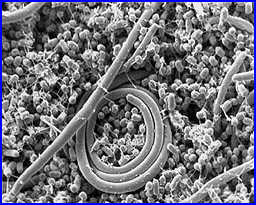



Rapid Salmonella Test May Reduce Meat and Produce Recalls
WASHINGTON - An innovative test to detect Salmonella in ready-to-eat meats has been developed by Agricultural Research Service (ARS) scientists. The preliminary test--still being evaluated by agency researchers - relies on PCR (polymerase chain reaction) technology to detect food-contaminating microbes on a molecular level.
Rapid Salmonella Test May Reduce Meat and Produce Recalls - WASHINGTON - An innovative test to detect Salmonella in ready-to-eat meats has been developed by Agricultural Research Service (ARS) scientists. The preliminary test--still being evaluated by agency researchers - relies on PCR (polymerase chain reaction) technology to detect food-contaminating microbes on a molecular level.
Food technologist Jitu Patel with the ARS Food Technology and Safety Laboratory, and microbiologist Arvind Bhagwat with the ARS Produce Quality and Safety Laboratory, in Beltsville, Md., compared their laboratory-developed “molecular beacon” test to a commercial rapid-detection test currently in use. While both tests can detect Salmonella in eight hours, the laboratory test is less expensive than commercial kits.
To evaluate the new test's efficacy, the scientists artificially contaminated various meats (turkey, bologna and ham slices) and produce (mixed salad, sprouts) with S. enterica serovar Typhimurium and allowed it to incubate for 20 hours. Both tests were sensitive enough to detect contamination in the meat products at an estimated level of two to four cells per 25 grams. In comparing the tests after a relatively brief incubation period of eight hours, two to four cells of Salmonella were detected in the 25-gram samples of meat as well as produce.
The ability of the molecular beacon test to detect very low levels of Salmonella contamination in eight hours will aid the food industry in quality assurance, helping prevent recalls of contaminated meats and produce by stopping the products from being introduced in the marketplace. Detection of contaminated foods could be achieved within a work shift--before shipment takes place.
Source: USDA Agricultural Research Service - 17th March 2006
 |
 |
 Salmonella enteritidis |
To evaluate the new test's efficacy, the scientists artificially contaminated various meats (turkey, bologna and ham slices) and produce (mixed salad, sprouts) with S. enterica serovar Typhimurium and allowed it to incubate for 20 hours. Both tests were sensitive enough to detect contamination in the meat products at an estimated level of two to four cells per 25 grams. In comparing the tests after a relatively brief incubation period of eight hours, two to four cells of Salmonella were detected in the 25-gram samples of meat as well as produce.
The ability of the molecular beacon test to detect very low levels of Salmonella contamination in eight hours will aid the food industry in quality assurance, helping prevent recalls of contaminated meats and produce by stopping the products from being introduced in the marketplace. Detection of contaminated foods could be achieved within a work shift--before shipment takes place.
Source: USDA Agricultural Research Service - 17th March 2006








